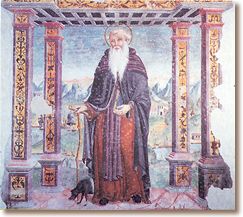|
 orriva
is the first town after the bridge Oltra. The Church of San Giorgio
lying on a fortified settlement offers a remarkable example of 16th-century
art, with its frescos by Andrea Nasocchio di Bassano (1514). The
cycle of frescos on the presbytery depict San Giorgio with the Drake,
Sant'Antonio Abate, prophets and Fathers of the Church besides grotesqueries
and putti. Moreover, above the works present in the nave there should
have been a cycle of frescos presumably executed by Marco da Mel.
Peculiar are the inscriptions on the walls, among which one shows
the year 1529. orriva
is the first town after the bridge Oltra. The Church of San Giorgio
lying on a fortified settlement offers a remarkable example of 16th-century
art, with its frescos by Andrea Nasocchio di Bassano (1514). The
cycle of frescos on the presbytery depict San Giorgio with the Drake,
Sant'Antonio Abate, prophets and Fathers of the Church besides grotesqueries
and putti. Moreover, above the works present in the nave there should
have been a cycle of frescos presumably executed by Marco da Mel.
Peculiar are the inscriptions on the walls, among which one shows
the year 1529.
 n
the way towards Servo you come across a fork leading to Zorzoi.
Off the main road, through a path in the wood you can reach the
fine church of San Rocco (also reachable from the road going from
Sorriva to Servo). It was consecrated in 1576 by Bishop Filippo
Maria Campeggio. Remarkable is the painting by Frigimelica (Madonna
in gloria) currently located in the dean church of Servo n
the way towards Servo you come across a fork leading to Zorzoi.
Off the main road, through a path in the wood you can reach the
fine church of San Rocco (also reachable from the road going from
Sorriva to Servo). It was consecrated in 1576 by Bishop Filippo
Maria Campeggio. Remarkable is the painting by Frigimelica (Madonna
in gloria) currently located in the dean church of Servo

|
 |
 oing
up towards Col dei Mich you can admire the fine 16th-century church
of San Zenone (presumably built on a watch tower) : Bishop of Verona
in the 4th century. Leading off the church is a mosaic via crucis
by the contemporary artist A. Bottegal. Inside a marmor altar of
Byzantine manufacture, altar attributed to Marco da Mel depicting
the Beata Vergine between the Saints Zenone and Silvestro as well
as painting with San Giuseppe attributable to Frigimelica (16th-
and 17th-century works). oing
up towards Col dei Mich you can admire the fine 16th-century church
of San Zenone (presumably built on a watch tower) : Bishop of Verona
in the 4th century. Leading off the church is a mosaic via crucis
by the contemporary artist A. Bottegal. Inside a marmor altar of
Byzantine manufacture, altar attributed to Marco da Mel depicting
the Beata Vergine between the Saints Zenone and Silvestro as well
as painting with San Giuseppe attributable to Frigimelica (16th-
and 17th-century works).
 rrived
at Servo, seat of the Town Hall, you need to peer through the houses
to discover the late-medieval church of Santa Maria Assunta (originally
dedicated to the Beata Vergine). It features some remarkable frescos
dating back to 1300 (Annunciation and Santa Caterina; Last Supper
with lobsters, presumably executed by Giovanni di Francia (15th
century), and possible author of the frescos at Santa Giustina in
Pedesalto. Other works dating back to 1514 are attributed to Giovanni
da Mel, (Sant'Antonio Abate, the Prayer in the Garden of Gethsemane
and the preaching of San Giovanni Battista), to Marco da Mel (Baptism
of Christ, tempera on board 1534) and to Frigimelica (Sant'Antonio
Abate, San Gottardo, San Valentino). It is presumably the most ancient
building of the upland, already mentioned in a Papal bull in 1185. rrived
at Servo, seat of the Town Hall, you need to peer through the houses
to discover the late-medieval church of Santa Maria Assunta (originally
dedicated to the Beata Vergine). It features some remarkable frescos
dating back to 1300 (Annunciation and Santa Caterina; Last Supper
with lobsters, presumably executed by Giovanni di Francia (15th
century), and possible author of the frescos at Santa Giustina in
Pedesalto. Other works dating back to 1514 are attributed to Giovanni
da Mel, (Sant'Antonio Abate, the Prayer in the Garden of Gethsemane
and the preaching of San Giovanni Battista), to Marco da Mel (Baptism
of Christ, tempera on board 1534) and to Frigimelica (Sant'Antonio
Abate, San Gottardo, San Valentino). It is presumably the most ancient
building of the upland, already mentioned in a Papal bull in 1185.

|






![]() Route
Churches
Route
Churches ![]() Route
Churches 2
Route
Churches 2



